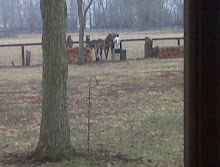OK, this is all well and good you say, but how do we measure these variables? And most importantly, how do we measure the horse's response to the workload?
Heart rate monitors have been around forever, but now many models come with a small (half a deck of cards sized) GPS unit. Now you can quantify speed, distance, altitude change, and the horse's physiological response to each. All takes place on-board while the horse is actually training, by the time he gets back to the barn - if you are waiting there with a stethoscope you have missed all the good stuff.
In addition, new lactate testing tools allow you to gather important blood data much like a human diabetic tests his/her insulin level, with a simple pinprick of blood - which is then immediately analyzed onsite.
This is lactate testing, not traditional blood counts done by the vet to pickup on illnesses or infections.
When a horse shows an increased ability to use blood lactate for energy, or an ability to remove the excess lactic acid from the bloodstream, that horse is being trained properly.
Lastly, computer software has been written to analyze and draw conclusions from all of the collected data - and the process has never been easier.
The above to be covered in more detail over the following days....thanks for reading!-
 Above is the visual depiction of a thoroughbred 'breezing' a half mile in :49 seconds.
Above is the visual depiction of a thoroughbred 'breezing' a half mile in :49 seconds. 




